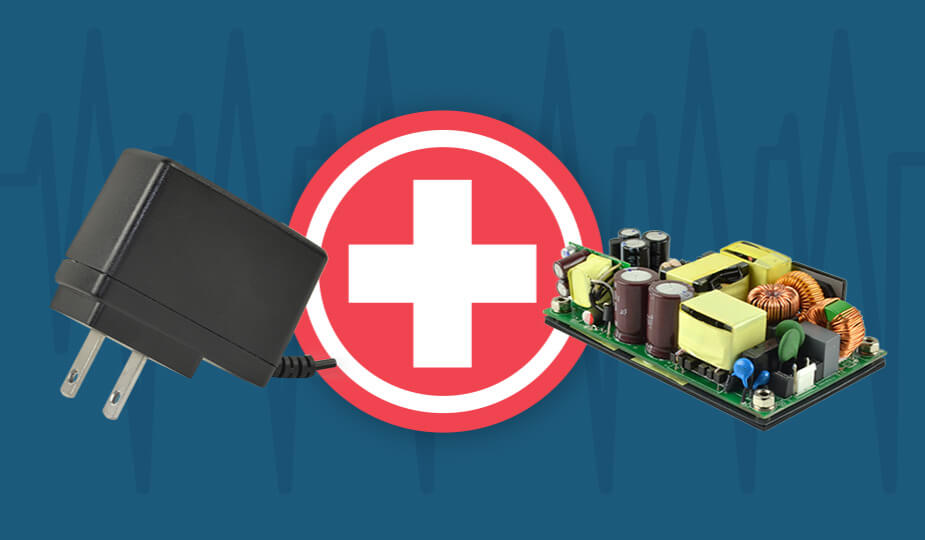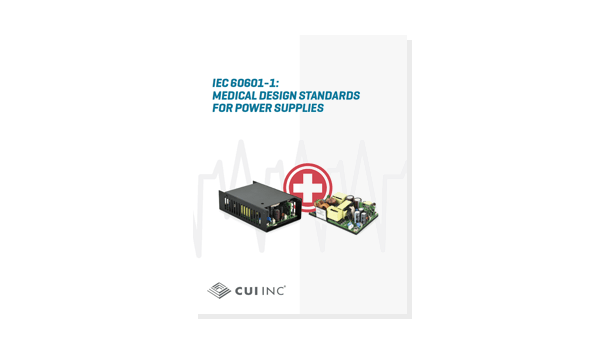IEC 60601-1-2 4th Edition: What You Need to Know
August 15, 2017 by CUI Inc -
5 Minute Read
Last updated February 12, 2019

Note: This post was originally published August 15, 2017 and updated on February 12, 2019 to reflect the latest timeline for adoption of IEC 60601-1 worldwide.
While all electrical equipment needs to be safe and not present a risk to the user, the circumstances under which medical electrical equipment may be operated can pose specific challenges. Consequently, it is not surprising to find there are international standards that govern the safety of medical equipment and define detailed technical design requirements with all the associated needs for testing and compliance certification.
While the original IEC 60601-1 standard has existed now for 40 years, technology has evolved and the environments where medical equipment is used has grown more complex. To keep pace with technological change, the standard has also evolved over time, and currently, equipment needs to comply with edition 3.1 in order to be readily sold in most countries around the world. However, that is soon set to change, with the introduction of a new set of requirements that address today’s needs for electromagnetic compatibility in different environments, such as the home, and in the presence of radio frequency signals, such as Wi-Fi, Bluetooth, and signals from mobile phones.
In the following post we will take a look at what the IEC 60601-1-2 4th edition EMC collateral standard calls for, how it relates to medical power supplies, and most importantly when it goes into effect in each region, so that you can be ready.
What are the new IEC 60601-1-2 4th edition requirements?
The main IEC 60601-1 standard (referred to in Europe as EN 60601-1 and in Canada as CSA 60601-1) is an umbrella for numerous subsidiary standards, variously known as “collateral” or “particular” standards. The 4th edition is strictly one of these collateral standards known as, IEC 60601-1-2 “Electromagnetic disturbances - Requirements and tests,” that has been extensively revised.
So, what has changed?
The underlying premise of IEC 60601-1 is understanding and managing risk, which the 3rd edition developed by defining electrical performance requirements for safe operation in terms of the means of protection for both patients and operators. Principally this determined isolation, creepage and insulation specifications for different classes of use. It should also be noted that edition 3.1 of the standard clarified some earlier definitions in the light of newer technologies.
The 4th edition EMC collateral standard maintains this focus on risk analysis, but moves away from equipment categories, such as “life-supporting,” and instead considers “intended use environments.” Specifically, it defines professional healthcare, home healthcare, and “special” environments. Professional covers the traditional use of medical equipment in hospitals and similar places where medical staff are present, but which these days are also subject to increased EMC challenges. Home use deals both with the requirements of non-specialist users as well as with situations where electrical supplies may be less stable. Special is a contingency for environments that may present high levels of electromagnetic disturbance, including industrial locations or in a radio-therapy treatment room.
Providing immunity to the sources of interference these environments may produce is the key to the more rigorous test specifications defined in the 4th edition, as the table outlines below.
| IEC 61000-4-2: ELECTROSTATIC DISCHARGE | ||
| Test | 3rd Edition | 4th Edition |
| Contact Discharges | ±2, 4, 6 kV | ±2, 4, 8 kV |
| Air Discharges | ±2, 4, 8 kV | ±2, 4, 8, 15 kV |
| IEC 61000-4-3: RADIATED RF IMMUNITY | ||
| Test | 3rd Edition | 4th Edition |
| Enclosures | 3 V/m, Life Support: 10 V/m 80% AM at 1 kHz or 2 Hz, 80 ~ 2500 MHz |
3 V/m, Home: 10 V/m 80% AM AT 1 kHz or risk frequency 80 ~ 2700 MHz |
| IEC 61000-4-4: ELECTRICAL FAST TRANSIENTS | ||
| Test | 3rd Edition | 4th Edition |
| Ac Mains or Dc Input | ±2 kV, 5kHz PRF | ±2 kV, 100kHz PRF |
| Input/Output Ports | ±1 kV, 5kHz PRF | ±1 kV, 100 kHz PRF |
| IEC 61000-4-11: VOLTAGE DIPS, DROPOUTS AND INTERRUPTIONS | ||
| Test | 3rd Edition | 4th Edition |
| Voltage Dips (16 A) | >95% dip, 0.5 periods 0° and 180° 60% dip, 5 periods 30% dip, 25 periods |
100% drop, 0/5 periods, 0°, 45°, 90°, 135°, 180°, 225°, 270°, 315° 100% dip, 1 period 30% dip, 25/30 periods |
How does IEC 60601-1-2 4th edition relate to power supplies?
Outside of battery-powered devices, it is not really possible to exclude power supplies from the IEC 60601-1 regulations that apply to medical equipment. This is evident from the previous 3rd edition classifications for patient and operator protection where a distinction is made between equipment in the same room as a patient, versus equipment that makes physical contact with the patient, especially in the case of contact with the patient’s heart, as with a defibrillator.
In the latter case, only IEC 60601-1 qualified supplies are acceptable and even then, an additional isolation barrier is required between the supply and the point of contact with the patient. Even excluding cardiac equipment, the isolation requirements for other uses are likely to impinge on the specification and performance of a power supply.
Likewise, the immunity requirements defined by the 4th edition impact power supply design, so equipment designers are best served to select medical grade power supplies that comply both with IEC 60601-1 edition 3.1 and the 4th edition EMC standards.
How long do I have to comply with IEC 60601-1-2 4th edition?
The global timeline for compliance with the various editions of IEC 60601-1, including the 4th edition EMC standards is fully detailed here. However, in broad terms, edition 3.1 is currently in force in the US, Canada, Europe, Japan, Korea, and Brazil. Other countries in Asia and elsewhere may be lagging as far as compliance for domestic use is concerned, but if manufacturers are producing equipment for export they will have to ensure compliance in the end-user country.
This same argument applies to the need for compliance with the 4th edition EMC standard which went into effect on a harmonized timeline in the US, Canada and Europe, from January 2019. For an equipment maker who is sourcing its power supplies from another manufacturer, the best solution to keeping on top of complex, evolving standards is to buy ready-qualified units. CUI offers both embedded and external power supplies from 6 watts to 550 watts that are fully compliant with the 4th edition EMC requirements of IEC 60601-1. By selecting one of these pre-certified models you can lessen the burden of ensuring compliance when it comes to medical device design.
Industry News , Safety & Compliance
You May Also Like
Have comments regarding this post or topics that you would like to see us cover in the future?
Send us an email at powerblog@cui.com




